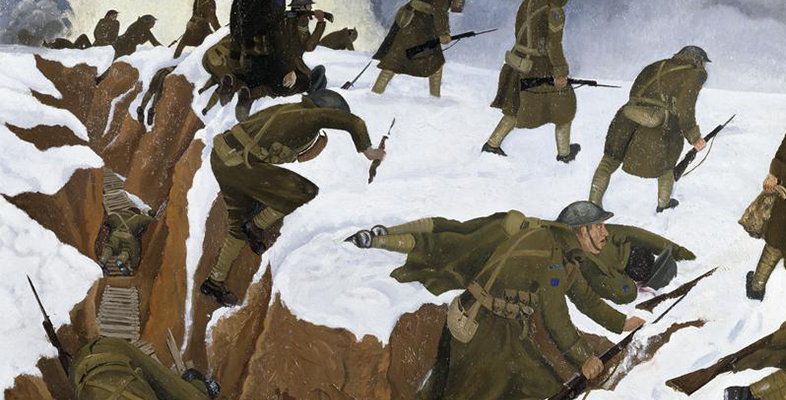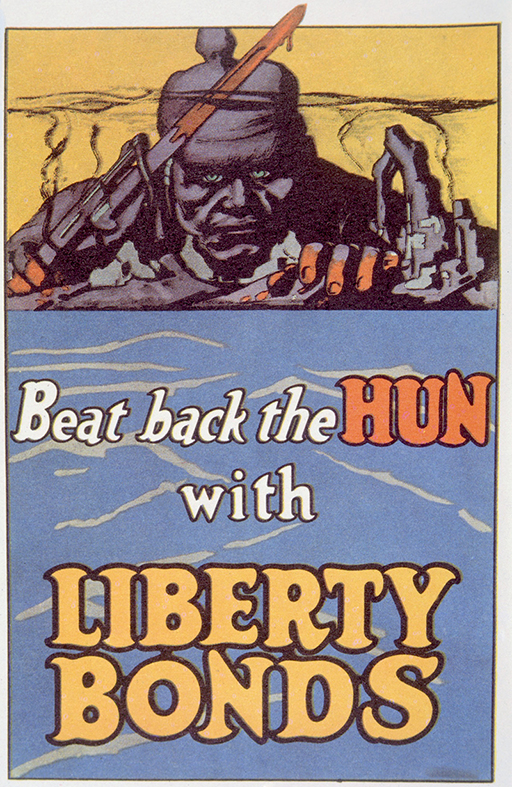4.2 American propaganda – Example 2
The second example is an American war-time poster from 1918. You have the option to consider each question yourself before revealing our specimen answers or use our worked example for students’ skills development.
Students’ skills development: Primary source analysis
Poster: Beat back the Hun with Liberty Bonds (1918)
Analysis
Who?
Answer
This is an American propaganda poster, drawn by Frederick Strothmann (his name is in the bottom right-hand corner) and commissioned by the Publicity Bureau of the United States Department of Treasury.
When?
Answer
The poster was produced in September 1918. By this stage the United States had been officially involved in the First World War for over a year, but its troops had only recently arrived in Europe in significant numbers. The poster was produced to coincide with the issue of the Fourth Liberty Bond (the purpose of this is explained below).
What?
Answer
The poster depicts a bestial and intimidating caricature of a German soldier staring across the ocean and by implication towards the USA. The German’s hands and bayonet are covered in blood, and he is surrounded by smouldering ruins (an allusion to German atrocities during the invasion of Belgium). The poster’s text, in bold lettering, says ‘Beat back the Hun with Liberty Bonds’.
Purpose
Answer
The poster’s purpose is to promote ‘liberty bonds’. Students may not be familiar with the concept of bonds, so it is worth explaining that, when people purchase a bond from the government, they are effectively loaning it money with the expectation that this money will be paid back with interest.
Like many other nations, in order to help fund its war effort, the American government sold bonds – branded as ‘liberty bonds’ – to the American public. There were four sets of bonds issued in the USA during the war – this poster was produced to promote the final wartime drive in September 1918. A fifth and final liberty bond, known as the ‘Victory Bond’, was issued in May 1919.
How?
Answer
To encourage the American public to purchase bonds, the poster demonises the enemy in a similar fashion to many other examples of Allied propaganda during the First World War. By alluding to perceived German aggression and barbarism, the poster builds on stereotypes that Allied propagandists had developed since the beginning of the conflict and particularly since the allegations of German atrocities in Belgium began to surface.
The use of the word ‘Hun’ – a derogatory nickname for the Germans, used by both the British and the Americans – was also commonly employed in Allied propaganda. It was intended to invoke the image of barbarism that was used in relation to the atrocities committed by German soldiers early in the war. The German soldier is looking across the ocean towards the USA, and the poster urges the American public to ‘beat back’ the Germans by supporting the war effort – in this sense, like the map from Life magazine (Example 1), it plays on fears of a German invasion.
Uses for historians
Answer
The poster is an excellent example of how American propagandists played on existing fears and stereotypes regarding Germany in order to persuade the American public to support the war effort. However, the poster itself does not help us to assess the success of these promotional efforts. To gauge this, we would need to look at other sources, including economic data detailing how much money was raised from the sale of the liberty bonds in the autumn of 1918.
In the next section you’ll find some useful resources for studying American propaganda in the First World War.

